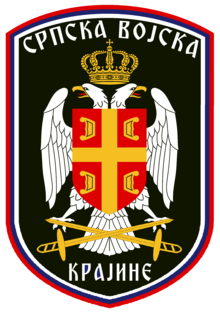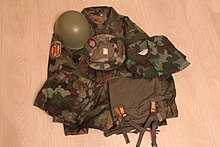| Serbian Army of Krajina | |
|---|---|
| Српска Војска Крајине Srpska Vojska Krajine | |
 Officer emblem of SVK, 1993–1995 | |
| Foundation | October 17, 1992 (30 years ago) |
| Dates of operation | 1992–1995 |
| Dissolved | August 7, 1995 (27 years ago) |
| Allegiance | |
| Headquarters | Knin |
| Size | 30,000[1] |
| Battles and wars | Operation Stinger, Operation Medak Pocket, Operation Maslenica, Operation Summer '95, Operation Whirlwind, Operation Flash, Operation Storm |
| Colors | (Serbian tricolour) |
| War flag |  |
The Serbian Army of Krajina (SAK, Serbo-Croatian: Srpska vojska Krajine, Српска војска Крајине, abbr. SVK), also known as the Army of the Republic of Serbian Krajina or Krajina Serbian Army, was the armed forces of the Republic of Serbian Krajina (RSK). The SVK consisted of ground and air elements.
Created through the merger of the Territorial Defense of the Republic of Serbian Krajina (TORSK), units of the Yugoslav People's Army (JNA) and the Krajina Militia, the SVK was officially established on 19 March 1992. Responsible for the security of the RSK, its area of responsibility covered an area of some 17,028 km² at its peak, as it was located entirely inland it thus had no naval forces. The SVK, along with the state of RSK, ceased to exist in 1995 following the Croatian military offensive Operation Storm.
| No. | Portrait | Commander-in-Chief | Took office | Left office | Time in office | Party | |
|---|---|---|---|---|---|---|---|
| 1 | Milan Babić (1956–2006) | 19 December 1991 | 16 February 1992 | 1 month | SDS | ||
| 2 | Goran Hadžić (1958–2016) | 26 February 1992 | 12 December 1993 | 1 year, 9 months | SDS | ||
| (1) | Milan Babić (1956–2006) | 12 December 1993 | 23 January 1994 | 1 month | SDS | ||
| 3 | Milan Martić (born 1954) | 23 January 1994 | 7 August 1995 | 1 year, 6 months | SPS | ||
| No. | Portrait | Commander | Took office | Left office | Time in office | Defence branch |
|---|---|---|---|---|---|---|
| 1 | Major general Mile Novaković (1950–2015) | 1992 | 1994 | 1–2 years | ||
| 2 | Major general Milan Čeleketić (born 1946) | 1994 | 1995 | 0–1 years | ||
| 3 | General Mile Mrkšić (1947–2015) | 1995 | 1995 | 0 years |
|
Main article: Main Staff of the Serbian Army of Krajina |



At the creation of the army, it was planned that its number would be 80,000 people, however it turned out to be less.
|
Main article: List of massacres in the Croatian War of Independence |
During the Croatian War of Independence, numerous massacres were conducted by the Army of Serbian Krajina. On 2–3 May 1995, seven civilians were killed and many more injured in the Zagreb rocket attacks.[4][5]
The main leaders of the Serbian Army of Krajina, Milan Martić, Milan Babić and Goran Hadžić, were indicted and trialled by the ICTY for various war crimes and crimes against humanity. Milan Martić was sentenced to 35 years in prison,[6] Milan Babić was sentenced to 13 years,[7] while Goran Hadžić died shortly after their trial started.[8]